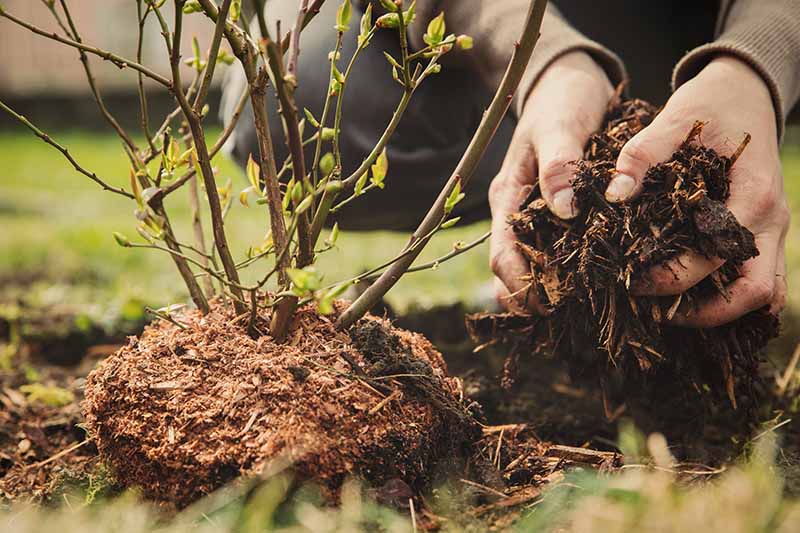Frost can often be deadly to our garden plants, but some good supplies, and a bit of dedication, will make a huge different in the protection of your plants.
Here's 5 ways you can provide ultimate protection...
Bring Potted Plants Inside
Potted plants are at the highest risk due to missing earth-based resources such as insulating heat from the ground, therefore making them rather vulnerable to root damage in the cold weather.
When frost is on the horizon, wait until the night before to bring any moveable potted plants, and hanging baskets, indoors. We recommend placing in a cool, dry place, such as your shed or garage. Do not store in any place that is warm- sudden temperature changes can shock the plants.
Please make sure you don't forget to inspect the plants for pests and diseases before bringing them inside, too.
When you feel the risk of frost has passed, you can bring the plants back outside-be sure to do this early in the morning.
Add A Heavy Layer Of Mulch
Think of adding mulch to your garden beds like pulling on a jacket before you go outside in the freezing, cold weather. It protects the plants from such sudden temperature drops, like it would with us.
We recommend using organic mulch matter, such as wood chips, straw, or even just a heap of leaves. Make sure you lay down about 3-6 inches of mulch, too, as you want to create a really good insulation barrier.
Please be sure to leave a slight gap around the stalk of the plant, however, as you want the warmth to be able to travel through the soil and up to the remainder of the plant.
Once the weather warms up quite a bit, ensure you pull away some of this mulch- you won't need as much when the weather is much warmer, even if it does make things a bit lower maintenance.

Water Your Plants In The Afternoon
This may sound confusing, but in fact, watering your plants when it's very cold will keep the soil moist and help protect them from the drastic temperature/weather changes, such as frost.
Moist soil has the ability to insulate heat very well, making it a handy little trick to water your plants in the afternoon/midday (the day before the frost).
Provide A Blanket
If you have long garden beds with groups of lovely plants, frost can often be a worry- especially when you don't have the resources to add lots of mulch, or the possibility to move them indoors! Therefore, in order to protect your plants, you can provide them with a "blanket." Bed sheets, towels, and blankets all work fine. You will need to place a few stakes around the garden bed/border, so that you're able to create a "tent."
Drape the material over the top of the plants, without pulling it down as far as the stems. Line bits of string over the top and tie at the stakes. Weigh down any of the corners with something heavy (i.e. stones).
You can use a plastic sheet for extra protection, but you cannot let the plastic touch the plant's foliage- it will cause more damage. Lay the sheet over the top of your other material and tie in at the stakes.
Another, neater, option is by using pre-made hooped house kits. They act like a tunnel, and can just be pulled over the plants overnight, then removed again first thing in the morning- you can't leave them on, as the plants need air and light to survive!
Wrap Tree Trunks
Young trees are very vulnerable to frost damage, and can sometimes go as far as killing them off!
Similarly, new buds and blossoms from fruit trees that are exposed to frost in spring will be stunted in their growth, resulting in a much lower harvest. Particularly, if temperatures drop as low as -1.5c, it's very important you protect your fruit trees.
Nonetheless, to protect any tree from the cold, you simply need to wrap up their trunks with blankets, cardboard, towels, or rags. It's also possible to use proper tree protector wraps or burlap, but the options mentioned before is a way to do it by using things around the house.
Begin at the base of the trunk, wrapping around as you go up. Overlap the layers, and keep wrapping up the same way until you come to the lowest branch. Secure this wrap with some tape or twine.
 Add How To Build a Number One Hairdressing Salon. This 5-Star Book Make The Impossible Possible In Your Salon. (£10.00)
Add How To Build a Number One Hairdressing Salon. This 5-Star Book Make The Impossible Possible In Your Salon. (£10.00) Add How To Increase Your Clients Outrageously Fast. Double, Triple and More Your Clients Using The NUMBER ONE and Proven WayTo Build New Clients (£10.00)
Add How To Increase Your Clients Outrageously Fast. Double, Triple and More Your Clients Using The NUMBER ONE and Proven WayTo Build New Clients (£10.00) Add How To Build a Number One Hairdressing Salon. This 5-Star Book Make The Impossible Possible In Your Salon. (£10.00)
Add How To Build a Number One Hairdressing Salon. This 5-Star Book Make The Impossible Possible In Your Salon. (£10.00) Add How To Increase Your Clients Outrageously Fast. Double, Triple and More Your Clients Using The NUMBER ONE and Proven WayTo Build New Clients (£10.00)
Add How To Increase Your Clients Outrageously Fast. Double, Triple and More Your Clients Using The NUMBER ONE and Proven WayTo Build New Clients (£10.00)
